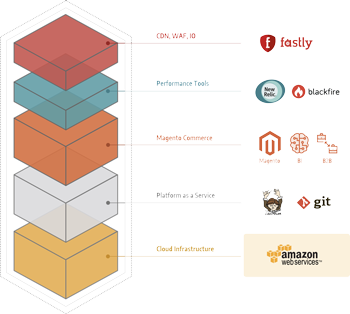There are a lot of options out there when it comes to hosting, developing, and updating your business’ website. Adobe Commerce, formerly known as Magento, is the best of the bunch—bringing everything together under one roof for maximum function at minimum cost.
1. Cloud-Based Hosting
When you move to this platform, cloud-based hosting, and everything you want to come with it, is included. They take care of the hosting as well as the requisite infrastructure and server security that come along with it. Bundling all these services allows Adobe Commerce clients to save a lot of money by not having to pay individually for equivalent-level options while also guaranteeing that the security is perfectly tailored to the specific hosting environment in a way that third-party security options can’t really guarantee.

Adobe Commerce also offers a persistent environment; this is huge, as it allows for multiple environments—say, separate staging and development instances—to run simultaneously so your team can test any new code safely before introducing it to the dev environment. While this may not be a wheel re-invention, it is an absolute must-have workflow best practice and it comes standard with Adobe Commerce.
2. Infrastructure & Monitoring
Tech StackOne of the biggest advantages Adobe Commerce offers over competing hosting options is high-level infrastructure for virtually guaranteed protection against downtime. Commerce comes packed with valuable built-in tools including Fastly, which provides a top-shelf web application firewall. Other perks include 24/7 support and, perhaps most valuable, infrastructure monitoring.
Setting up this level of infrastructure monitoring on your own—without factoring any other costs such as hosting, security, or development—would cost around $5k per month. Simulating the functionality of other features like Fastly outside for the Adobe Commerce environment would likewise spike costs, but it’s all neatly bundled in Adobe Commerce to keep your costs predictable and your bottom line higher.

3. Page Builder & B2B Tools
Beyond having the best “nuts and bolts” hosting, infrastructure, and monitoring options, Adobe Commerce’s enterprise-level platform also comes fully loaded with elite development tools and features. Page Builder allows for improved functionality, including an incredible array of easy-to-use page layout options and the ability to create Product Detail Pages. It also presents further savings opportunities since there’s no need for an external CMS for your front-end content.
Adobe Commerce also offers B2B capabilities, most notably customer segmentation options all the way down to the account level. This is especially important for multi-brand users, as is the Adobe-exclusive ability to run multiple stores under one single system—including those with separate domains and subdomains. That multi-store functionality can save a massive amount of time and labor, allowing one system to govern an entire house of brands as easily as a single storefront.
All of the functionality and features described above are valuable in their own right, but what really differentiates Adobe Commerce from other commerce solutions is its centralized approach. Everything comes from the same place and is governed by the same systems. The security and functionality are made by the same company that handles the hosting, and every facet is designed to perfectly synchronize and complement the others.
With Adobe Commerce, you can manage your entire online storefront (or storefronts) in one place, without the need for dozens of peripheral add-ons, and feel safe knowing that Adobe's included support covers the whole suite, from foundation to implementation.
Essentially it’s a better product that costs less, does more, is easier to use, and is supported by a better infrastructure and customer support. Kind of a no-brainer when we put it like that.
